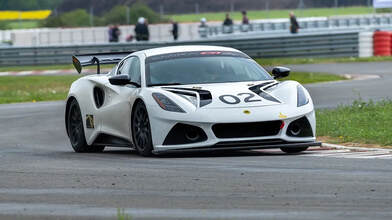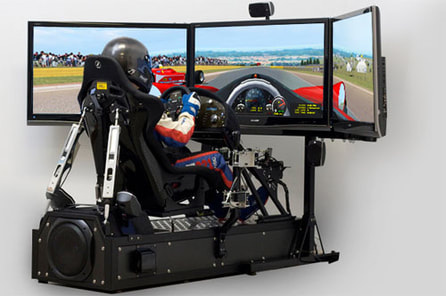| For part 2 in this Racing Line Fundamentals series, we’re going to explore the factors that determine the ideal apex and line through a corner. We’ll learn how a vehicle’s ratio of acceleration compared to its cornering ability governs the ideal apex a driver needs as well as how this influences the line the vehicle will take through a corner. | 1. The Acceleration Point 2. The Ideal Apex 3. The Chicane 4. The Double Apex 5. The Straightaway 6. The 90-Degree Limit |
|
10 Comments
Steering Feel Explained – How Forces At The Tire Contact Patch Are Transferred To The Steering Wheel7/11/2023  Long waits for a car delivery apparently bring out the obsessive part of me almost as much as the physics of racing. I placed a deposit for the new Lotus Emira back in May of ‘22, in Hethel Yellow of course, and still don’t have a definite delivery date. During the long wait, I can’t help but regularly dig for the latest info, and one subject I often see brought up is questions and opinions on the steering feel of the Emira. Lotus is renowned for having great steering in their cars, but even most professional reviewers seem to get quite vague when discussing steering feel. So in this article, I wanted to look at this subject more in depth and learn what exactly the steering wheel is trying to tell us. As a follow-up to my last lesson, The Truth About Trail Braking, I wanted to take deeper look into the physics behind trail braking. In this lesson, we'll explore the reasons we trail brake as well as when and how it should be done. We'll also dispel some common misconceptions along the way.
Trail braking is one of the more misunderstood techniques in motorsport so in this lesson I will be talking a little bit about what trail braking is, but also importantly, what it isn’t. Plus, I’ll go over some training techniques to help you on your way to becoming a corner entry expert.
The racing line is much more than just the path you take around a racecourse. You can't just follow a certain line around a course and expect a good result. The ideal lap is the result of optimizing the forces acting on a vehicle, and the actual line taken is simply the result of this. The science of optimizing these forces is called line theory and when we introduced line theory with the Science of Speed Series, it was naturally accompanied by extensive explanation. But while a full explanation spans three books, the key line theory rules that a driver needs to know are actually quite basic and I’ve often found myself saying that I could probably fit them all on a single sheet of paper. I’ve also often found myself needing just such a quick reference guide, so this article is my attempt at creating a quick guide to the rules of the racing line. For a more complete explanation of the racing line, see the Racing Line Fundamentals lesson series.
 In my role as a racing coach, I’ve had the opportunity to analyze the videos of many different drivers, but I’m also often asked for my take on other notable driving videos as well. Of all the famous driving videos out there, I have probably been asked about the Senna at Suzuka video more than any other. You know, the one where he’s casually wringing the neck of an Acura NSX while sporting white socks and loafers. Even if you aren’t a driving enthusiast, it’s definitely worth a look for nostalgic fashion purposes alone.  When I start working with a driver, one of the first things I ask is if they have a sim racing setup to train on. As often as not I hear some variation of the question "Are those actually real enough to be helpful?" We just started releasing some of the training exercises we use with drivers publicly so I thought it would be a good time to do an article that will hopefully answer that very question.  Imagine a drag race between two identical cars. A very unique drag race as shown in the illustration below. One car starts normally, but the other car showed up late so the race starts right as the driver enters their lane perpendicular to the start line. Which car would win? In this lesson, we’ll not only look at the answer, but learn how it can help us optimize our driving on a race track. We'll get to that later, but first let's play a game.  In this article we are not only going to learn how to calculate load transfer in a vehicle, but more importantly, learn to visualize how the forces are acting between the car and the tires. Understanding these forces becomes very important when we move on to articles dealing with car balance, roll centers, and almost all things suspension related. If you haven't read our tire science article, make sure to go through that first, particularly the section on load sensitivity, as we will be using those concepts here.  We have some upcoming articles where a basic knowledge of how tires work will be needed so we've put together a brief overview. Tire science is incredibly complex, but there are certain aspects that can be quite important for a racing driver to understand. In this article, we will go over load sensitivity, slip angle and induced drag, as well as slip ratio.  As a supplement to our Racecar Setup Guide, we've created a flowchart to give those newer to car setup a starting game plan to follow. This chart represents a good basic setup philosophy that covers the primary elements that affect vehicle handling and performance. It will give a driver something to build on and tailor to their own needs as their vehicle dynamics knowledge expands. This flowchart shows a balance-based approach where no advanced telemetry or tools will be needed. A driver will primarily use their ability to detect understeer and oversteer to work toward a good setup. This is an approach that will grow with driver skill and as you become more sensitive to car balance, you will be able to hone in on a better and better setup. Seemingly simple, but surprisingly complex, kart racing is as full of secrecy as it is misunderstanding. This leaves many curious karters searching for real answers. We don't much like secrecy or misunderstanding so in this two-part article we will look at the unique considerations of karts. Even if you aren't the solid-axle sort however, learning about karts can teach you a lot about the more "advanced" racing classes.
The center of gravity (CG) of an object is its center of mass by which all acceleration forces act through. It’s an imaginary point where if you could suspend the object from that location, it would be balanced in all directions. In a kart, this point is generally somewhere right in front of where the driver sits. Since the driver is such a large percentage of the overall weight of a kart, moving around a lot can cause the center of gravity to also move around by a significant amount. Some karters will actually move on purpose to alter handling. For instance, you could lean back as you brake to put more weight on the rear tires to allow improved braking.
 We've put together a quick-reference infographic of the racing line covering the whole apex spectrum. From the lowest-acceleration early apex to the fastest late apex. Virtually every vehicle would ideally travel somewhere between these two lines. The graphic covers everything from turn-in points and apex angles to the appropriate steering, throttle, and braking needed along the continuum of apexes. You'll learn what kinds of corners and cars need earlier and later apexes as well as the key differences as your apex angle moves along the inside of the track. See how cars capable of high-acceleration in a corner need a later, slower turn-in and a slower, tighter radius to more effectively use their power during corner exit.  We use the term Line Theory for the physics-based set of rules a driver can use to work toward an ideal line on a racetrack. This is great for those drivers who have hit their wall or at least have a few events under their belt and can get around a track somewhat competently. It allows a driver to slowly chip away at their mistakes as they reach ever closer toward their ultimate potential.  This guide will give you a procedure to follow to start optimizing the setup on virtually any car. So as not to fill the guide with repeated information, it is assumed the reader has a basic knowledge of racing and setup terms. Readers may want to look through our Racing Terms Glossary first. This guide is primarily aimed at road course racing in cars, but will have some use for kart and oval racing as well. Also, understand that learning vehicle dynamics and setup can be a very complex subject. This guide is simply a jumping off point to hopefully get you in the proper mindset for learning about car setup and we are glazing over a lot of the background information needed to truly understand the "why.” Myths spread because, on the surface, they often seem to make sense. The racing world most likely has so many of these myths because not only are they often born from good basic advice, but also because of the massive influence driving skill has on lap times. A suboptimal racing line driven perfectly will almost always beat an ideal racing line driven poorly. This has allowed some of these less than ideal techniques to evolve into supposed truths that are in fact, not. I spend a good deal of time helping drivers unlearn these "truths," so in this article I'll go over the five big ones that you hear repeated over and over. Hopefully this will help some newer drivers skip the unlearning part and go straight to the learning.
Head instructor and author Adam Brouillard takes you through a lap of Lime Rock Park in the iRacing Global Mazda MX-5 Cup car.
This is a follow-up to my previous article about reducing motion sickness in sim-racing titles. The topic of whether or not the view should be locked to the horizon in sim-racing titles was hotly debated when it was first introduced years ago and this sim-racing civil war has not in any way subsided. I wanted to write this follow-up to shed some more light on the subject and hopefully bring about a ceasefire. We'll first go a little more in-depth into the the science and then talk about the pros and cons of horizon locking as well as how each individual might want to use it.
I'm a big advocate of sim racing as a motorsport in its own right and also as a great training tool for real world competitors. For many racers, virtual reality has brought sim-racing to a whole new level and you hear many stories of elation from drivers after donning a VR headset for the first time and experiencing the cockpit of their favorite exotic sportscar as if they are really there. For some however, that elation is short lived once they pull out onto the track and the first few corners make them start to wonder if they might be seeing their lunch again soon.
|
Driving tips, setup tech, and other racing knowledge.
1. The Acceleration Point
2. The Ideal Apex 3. The Chicane 4. The Double Apex 5. The Straightaway 6. The 90-Degree Limit |











